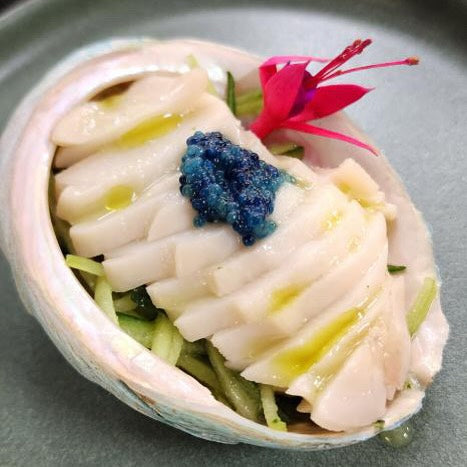Abalone has long been popularly associated with Chinese feasts and reunions, and with good reason, but in many places around the world, including Australia, abalone is an Indigenous ingredient with its own associated traditions and customs, unique and meaningful to the First Peoples of each coastline.
The word abalone itself is from the language of the Rumsen Ohlone, from the Monterey Bay region of California. During Spanish colonisation, the Rumsen word aulón became abulón, which later became abalone in English.
In Aotearoa-New Zealand, abalone is known as pāua, its Māori Language name.
And in Australia too, abalone is a native ingredient – a bush food, or more accurately, a Sea Country food, with different names in different local languages around the nation/s.
Here on Gunditjmara Country, variations on words for abalone come from the Peek Whurrong and other local Language groups. Two calm bays behind the farm just west of Port Fairy have produced abalone for thousands of years.
Nearby, ancient shell middens* show where Gunditjmara (and others?) gathered, fished and enjoyed shellfish, including abalone.

Did you know that in Australia, abalone was once known as mutton fish – and in certain areas, still is? Read more in Mutton Fish: The Surviving Culture of Aboriginal People and Abalone on the South Coast of New South Wales, published by AIATSIS.
As an abalone farm, we recognise that the tiger abalone we cultivate (raised from greenlip and blacklip abalone) is part of the rich and enduring food systems of coastal First Nations peoples wherever abalone is found or shared.
We believe farming abalone eases pressure on wild populations, helping preserve both wild and farmed abalone for the future – for food security, for biodiversity and for cultural continuity.
We encourage all abalone lovers to take some time and learn more about abalone from Gunditjmara Country, part of the Eastern Maar Nation, and the native coastal plants that also grow here and pair beautifully with abalone in the kitchen, offering a truly local and seasonal way to cook and connect.

*What’s a midden?
A midden is an ancient cultural site where generations of people left behind shells, bones and other traces of daily life, offering a window into how people at that location lived. Today, many middens are protected as sacred or heritage sites, valued for cultural, historical and environmental significance.




Leave a comment
This site is protected by hCaptcha and the hCaptcha Privacy Policy and Terms of Service apply.